Join More Than 50,000+ Subscribers and get latest camera news and rumors
NEW CAMERA VIDEOS ON YOUTUBE
|
By admin, on July 26th, 2024
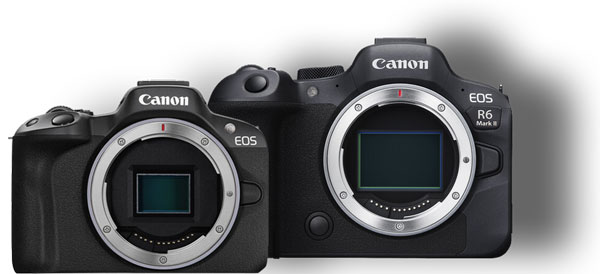
Canon R6 Mark II and Canon R50 are the most sold models of Canon. Imagine a business in the year of 2024, the first and second quarter, which is written in the Canon’s latest financial report, and more or less, these two cameras are also responsible for Canon’s financial recovery. Let’s have a look
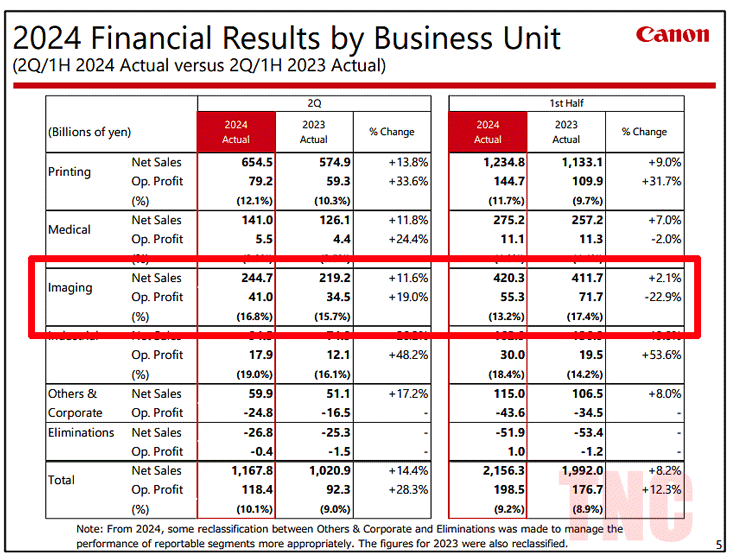
Canon official Finical REPORT of 1st half of 2024 – Conference on results for 2Q 2024 (July 25, 2024)
In the Imaging Business Unit, interchangeable-lens digital camera’s performance was solid due to steady sales of the EOS R6 Mark II full-frame mirrorless camera and the new entry-level EOS R50, along with increased sales of digital compact cameras. Although sales for network cameras decreased temporarily in the previous quarter of this year due to the adjustments of inventory levels in the market, sales for the second quarter of network cameras increased thanks to need for diversified applications. As a result, sales for the second quarter of the Imaging Business Unit increased by 11.6% compared with the same period of the previous year to ¥244.7 billion, while income before income taxes for the second quarter increased by 19.3% compared with the same period of the previous year to ¥41.7 billion. Sales for the first half of the year totaled ¥420.3 billion, a year-onyear increase of 2.1%, while income before income taxes totaled ¥56.6 billion, a year-on-year decrease of 21.9%.
REPORT ANALYSIS
Canon’s Imaging Business Unit had a mixed performance. They sold many cameras like the EOS R6 Mark II and EOS R50, which boosted sales by 11.6% to ¥244.7 billion. However, their overall income before taxes for the first half of the year dropped by 21.9% to ¥56.6 billion compared to last year. This means while they are making money, their profit has decreased compared to before, so they haven’t fully recovered yet.
Get LIVE RUMORS –> FACEBOOK | TWITTER | INSTAGRAM to get live news + Canon rumors 24X7
source – global.canon/en/ir/
By admin, on February 19th, 2024
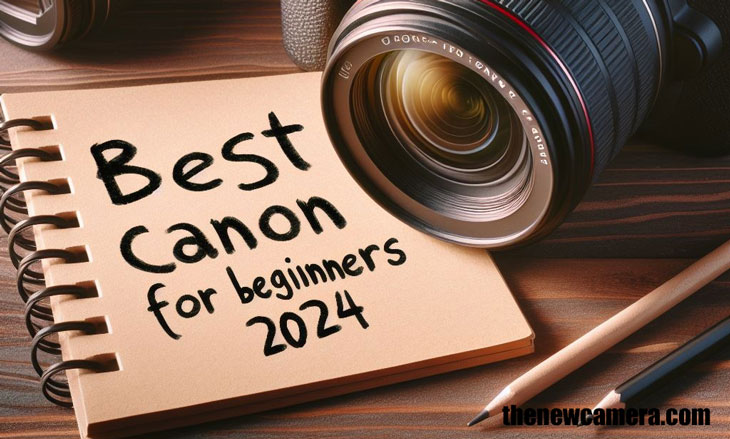
A lot of people are still buying the Canon T7 camera. Is it a good camera? Should you also buy a T7 and save a few bucks, or should you go towards the mirrorless lineup of Canon?
The biggest issue with DSLRs like the Canon T7 is the limited 9-point focusing mechanism. So if you are planning to buy a DSLR like the Canon T7, you should forget about the eye autofocus tracking that we have in mirrorless cameras. With the help of eye autofocus tracking, you can get properly well-focused images of the subject without any hassle.
But if you use the Canon T7, then you have to place the subject to fit inside the 9 centered autofocus points of the camera. Among one of the 9 points, you have to focus on a single point that falls on the same plane as the subject’s eye. I mean to say, mirrorless autofocusing mechanisms are now much faster compared to the DSLR face detect autofocus system. Since I have used both DSLRs and mirrorless cameras, I am sharing my personal experience with you.
| Feature |
Canon T7 |
Canon R100 |
| Sensor |
24-megapixel CMOS |
24.1-megapixel CMOS |
| Image Processor |
DIGIC 4+ |
DIGIC 8 |
| Subject Recognition |
Limited 9-point focusing mechanism |
Recognizes people (eyes, faces, and heads), animals (specifically dogs, cats, birds, and horses), or vehicles (motorsport cars and bikes, trains, and aircraft) |
| Continuous Shooting Speed |
Up to 3 frames per second |
Up to 6.5 frames per second |
| Display Screen |
Fixed, non-touch |
Fixed, non-touch |
| Video Recording |
Maximum continuous recording time for a single video of 29 minutes and 59 seconds | No Continous Video AutoFocus |
4K 25p or HD 120p | DPAF Fulltime AF | Eye AF tracking | 3D object Tracking |
| Weight |
Approx. 475 g |
Approx. 356 g |
| Image Quality |
Same as Canon R100 [Almost] |
Inferior to Canon R10 and R50 |
So the biggest downside of DSLRs like the Canon T7 is that they don’t have an algorithm for tracking, and hence the autofocus system is completely useless compared to the Canon mirrorless cameras we have.
The other biggest difference you will notice, apart from struggling with autofocus points, is the continuous autofocus feature in the video. DSLRs like the Canon T7 don’t have a continuous autofocus feature in video.
1. Best Canon Camera for Beginners Under $500
These are the limitations we have with the Canon entry-level DSLRs, and fortunately, the Canon R100 camera is in the same price range as the Canon T7 DSLR. So if you don’t have the budget to spend on Canon’s higher-end models, the R100 could be a good option.
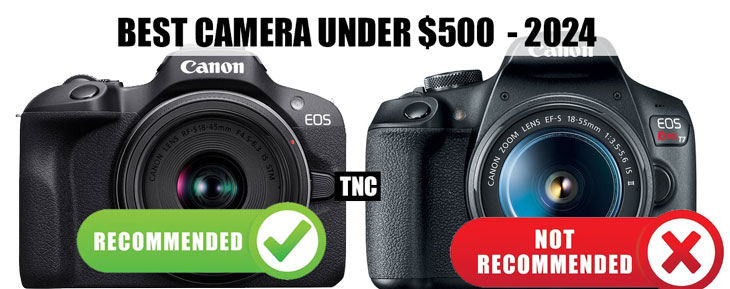
Recommendation: For Photographer, we highly recommend Canon R100 camera under $500 Range
Get The Best Canon R100 Camera – Amazon.com | B&H Store USA
2. Best Canon Camera for Beginners Under $700
Let’s compare the Canon R50 camera with the Canon R100 camera and clear up any confusion about which camera you should buy as a beginner.
| Feature |
Canon R50 |
Canon R100 |
| Sensor |
24-megapixel CMOS |
24.1-megapixel CMOS |
| Image Processor |
DIGIC X |
DIGIC 8 |
| Subject Recognition |
Recognizes people (eyes, faces, and heads), animals (specifically dogs, cats, birds, and horses), or vehicles (motorsport cars and bikes, trains, and aircraft) |
Recognizes faces and eyes, but for animal and car detection, you’ll need to step up to the more expensive EOS R50 |
| Continuous Shooting Speed |
Up to 15 frames per second |
Up to 6.5 frames per second |
| Display Screen |
Vari-angle | Fully Touch |
Fixed, non-touch |
| Video Recording |
4K 30p (6K oversampled) & FHD 120p |
4K 25p & HD 120p (No Oversampling) |
| Weight |
Approx. 328 g (375g with card and battery) |
Approx. 356 g |
| Image Quality |
Same as Canon R10 |
Inferior to Canon R10 and R50 |
We have some limitations here. The limitation is that we do not have Canon R50 camera samples. We have the R10 and R100 samples. The good thing is both of these cameras use the same sensor. Not only the same sensor, the Canon R50 and the Canon R10 cameras use the same image processor. Only the Canon R100 camera uses the older DIGIC 8 image processor, since the Canon R10 and R50 share the same image sensor and processor the image quality of the cameras will remain the same.

Looking at the samples, we can notice that there is a one-stop difference between the two cameras. So, we do have technical core differences between all these three cameras. The R100 camera uses the older image processor, has a 6.5 per second continuous shooting speed, and doesn’t have a touch display screen. That display screen is also fixed, so we have a lot of limitations with this camera. Associated with these limitations, we get inferior image quality in the Canon R100 camera compared to the other two on the list.
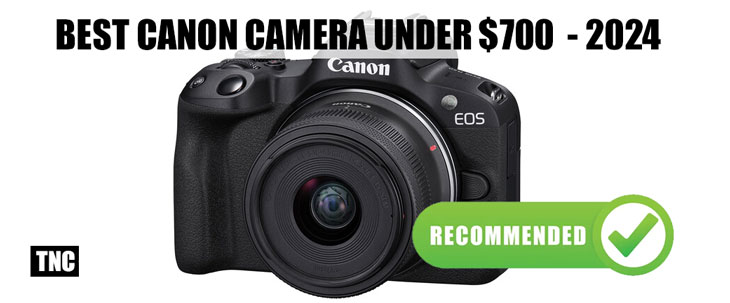
Best Canon Camera Under $700 Price Range Canon R50 – Amazon.com | B&H Store
So, for those who are looking to buy the Canon R100 camera, I would say that there is a very small price difference between the Canon R50. If you can manage to buy the R50 camera, you should at any cost. It’s highly recommended to you. Since you’re getting inferior core specifications along with the Canon R100 camera, you are also getting inferior image quality. So, steer clear of that.
3. Best Canon Camera for Beginners Under $1000
Let Us compare the Canon R50 and Canon R10, and find out the reason why should you buy the Canon R10 instead of Canon R50 if you have approx $1000 budget for your camera in 2024.
| eature |
Canon R10 |
Canon R50 |
| Sensor |
24MP APS-C CMOS |
24.2MP APS-C CMOS |
| Image Processor |
DIGIC X |
DIGIC X |
| Low Light Performance |
Almost same as Canon R50 |
|
| Mechanical Shutter Speed |
Up to 15 fps |
Up to 12 fps |
| Electronic Shutter Speed |
Up to 23 fps |
Up to 15 fps |
| Video Recording |
4K 30p full sensor & 4K 60p cropped |
4K 30p full sensor |
| Weight |
Approx. 429 g |
Approx. 375 g (lighter) |
| Image Quality |
Similar |
|
| Subject Recognition |
People (eyes, faces, heads), animals (dogs, cats, birds, horses), vehicles (motorsports cars/bikes, trains, aircraft) |
People (eyes, faces, heads) |
| Autofocus Points |
651 AF Zones | 4503 individually selectable AF points |
same as Canon R10 |
| Physical Dials/Buttons |
More dedicated dials and buttons for manual control [Joy stick on the rear side] |
Fewer physical controls, relies more on touchscreen |
| Battery Life |
CIPA rated 430 shots |
CIPA rated 390 shots |
| Headphone Jack |
Yes |
No |
Among all these three cameras, as I have said, if your budget allows, you should go with the Canon R50. But again, if you talk about the best of all these three, then without a doubt, the Canon R10 is superior.
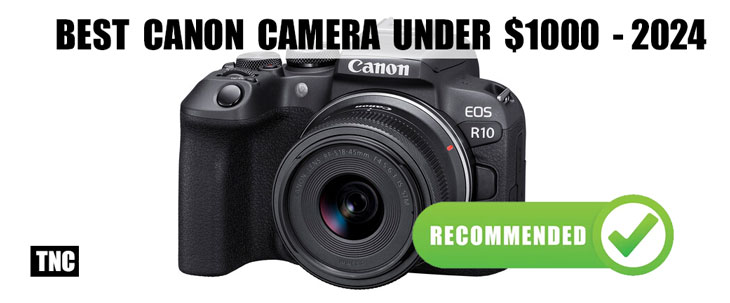
Buy Canon R10 Camera from Amazon.com | B&H Store
Why so? With this camera, you are getting a pre-shooting buffer, a feature that professionals will love to use. Other features include a 15 FPS mechanical shutter that will give you zero distortion while capturing images. The mechanical shutter speed of the R50 is limited to 12 frames per second. If we compare the electronic shutter speed in the Canon cameras, the R10 has a higher speed.
Other features include lens breathing correction, a better, higher resolution display screen, and the ability to record 4K videos at 60 frames per second with some crop.
* We have excluded the Canon M series cameras since they have been completely discontinued and even their Lenses are not usable on any mount | So in 2024 kindly don’t invest in the EOS M Series
Lets me know if you have any further questions
By admin, on May 16th, 2023
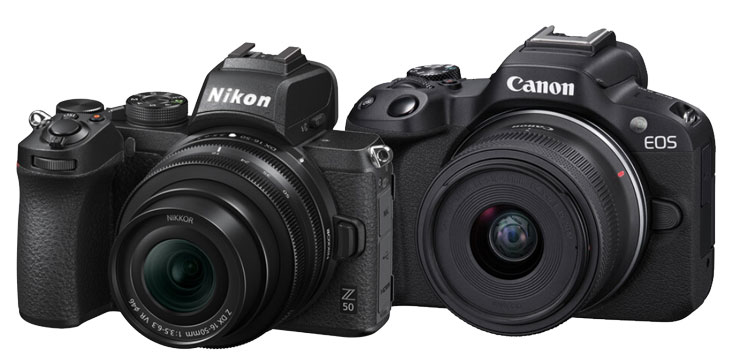
Latest comparison of the design part of the Canon R50 versus the Nikon Z50 camera. Canon R50 features a very ultra-compact body. The big difference between the two is weather sealing. If you shoot mostly outdoors, Z50 and even Z30 feature weather sealing in their body. No weather sealing is present in Canon R50.
Both cameras feature a built-in flash as well as an EVF. They are almost the same. The Canon R50 features a vari-angle display, while the Nikon Z50 features a limited-tilt display screen.
Canon R50 vs Nikon Z50 – Table of contents
Due to the design issue, the Canon R50 camera is more content-creator-friendly when compared to can Nikon Z50
also, see – Canon R10 vs Nikon Z50
Best Lenses for Canon R50 Camera
|
Canon R50 |
Nikon Z50 |
| Lens Mount |
Canon RF |
Nikon Z |
| Sensor Resolution |
Effective: 24.2 Megapixel |
Actual: 21.51 Megapixel
Effective: 20.9 Megapixel (5568 x 3712) |
| Image Sensor |
22.3 x 14.9 mm (APS-C) CMOS |
23.5 x 15.7 mm (APS-C) CMOS |
| Crop Factor |
1.6x |
1.5x |
| Image Stabilization |
None |
Digital (Video Only) |
| Built-In ND Filter |
None |
None |
| Capture Type |
Stills & Video |
Stills & Video |
1. Best Camera for Photography – Canon R50 vs Nikon Z50
Both cameras use an APS-C CMOS sensor. Nikon calls it DX and as you can see, physically the DX sensors are slightly larger compared to the Canon APS-C sensor.
- Nikon’s DX: 23.5 mm x 15.7 mm
- Canon’s APS-C: 22.3 × 14.9 mm
Okay, that doesn’t make too much difference, but since the sensor resolution of Nikon Z50 is 20MP and the sensor size is slightly larger, then due to these two factors automatically the low light performance of the camera upscales compared to others.
If you look at the ISO range chart, then you will see a massive difference between the ISO range of the Canon R50 camera and the Nikon Z50. The maximum ISO range of the Canon R50 camera goes up to ISO 51200 whereas the Nikon Z50’s ISO range is expandable up to 204800.
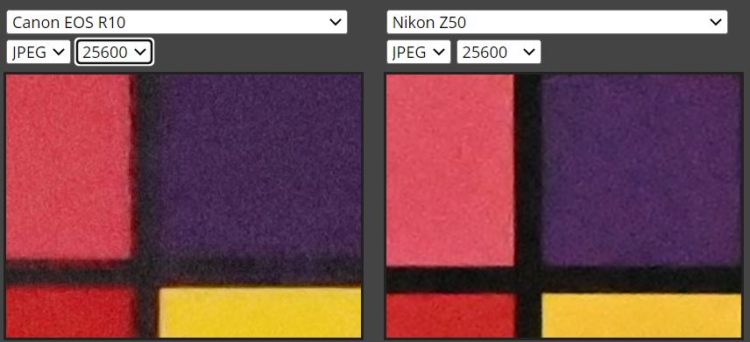
Since R10 samples are not available at this moment we are picking up, the Canon R10 (both Canon R10 and R50 share the same sensor)
Not only in words and numbers, let’s compare the two practices and try to find out the best camera between these two. As you can see, the ISO range of the Canon camera limits to 25600. Comparing the two, it’s very clear that the Nikon Z50 camera is able to preserve color details in a much better way. As you can see, the color box lines are not melting into each other. Canon R50 is not able to resolve colors at higher ISO ranges.
|
Canon R50 |
Nikon Z50 |
| Shutter Type |
Electronic Shutter |
Electronic Shutter, Mechanical Focal Plane Shutter |
| Shutter Speed |
Electronic Shutter
1/8000 Up to 30 Seconds
Electronic Front Curtain Shutter
1/4000 Up to 30 Seconds |
Electronic Front Curtain Shutter
1/4000 to 30 Seconds
Electronic Shutter
1/4000 to 30 Seconds |
| Bulb/Time Mode |
Bulb Mode, Time Mode |
Bulb Mode, Time Mode |
| ISO Sensitivity |
Photo/Video
100 to 32,000 (Extended: 51,200) |
Photo
100 to 51,200 in Auto Mode (Extended: 100 to 204,800)
Video
100 to 25,600 in Manual, Auto Mode |
| Metering Method |
Center-Weighted Average, Evaluative, Partial, Spot |
Center-Weighted Average, Highlight Weighted, Matrix, Spot |
| Exposure Modes |
Aperture Priority, Manual, Program, Shutter Priority |
Aperture Priority, Manual, Program, Shutter Priority |
| Exposure Compensation |
-3 to +3 EV (1/3 EV Steps) |
-5 to +5 EV (1/3, 1/2 EV Steps) |
| Metering Range |
-2 to 20 EV |
-4 to 17 EV |
| Continuous Shooting |
Electronic Shutter
Up to 15 fps for up to 28 Frames (JPEG) / 7 Frames (Raw)
Electronic Shutter
Up to 12 fps for up to 42 Frames (JPEG) / 7 Frames (Raw) |
Up to 11 fps at 20.9 MP
Up to 5 fps at 20.9 MP
Up to 4 fps at 20.9 MP
Up to 30 fps at 8 MP |
2. Autofocus – Canon R50 vs Nikon Z50
Both of them use completely different technology. Canon uses Dual Pixel CMOS autofocus technology and Nikon uses hybrid.
- The Canon R10 DPAF points are fabricated across the entire sensor, with a maximum of 4,503 points (single area mode) or 651 ZONES (when Tracking is enabled).
- The Z50 has 273 points that cover approximately 90% of the sensor. So technically we have less number of AF points inside the Nikon Z50 Mirrorless camera.
|
Canon R50 |
Nikon Z50 |
| Focus Type |
Auto and Manual Focus |
Auto and Manual Focus |
| Focus Mode |
Continuous-Servo AF, Manual Focus, Single-Servo AF |
Automatic, Continuous-Servo AF, Full-Time Servo, Manual Focus, Single-Servo AF |
| Autofocus Points |
Photo
Phase Detection: 4503
Video
Phase Detection: 3713 |
Phase Detection: 209 |
| Autofocus Sensitivity |
-4 to +20 EV |
-2 to +19 EV |
If you compare the autofocus points of the two, then you will see a massive difference. Don’t get demoralized after looking at the fewer number of points in Nikon Z50 camera. It is also highly usable and a perfect companion for general-purpose photography. You can also shoot sports and wildlife with this but don’t expect Hi-Fi 3D AF tracking performance from this camera.
If you are more into sports and wildlife photography and love to have a perfect camera under budget, then I highly recommend you to get the Canon R50 camera if possible, which has the fastest burst speed of 23 frames per second.
3. Best Camera – AF sensitivity – Canon R50 vs Nikon Z50
The stats say, the Canon R50 has a minimum sensitivity in the low light of -4EV, which is excellent for a class of camera like the Canon R10. The AF sensitivity of measured with an F1.2 lens is practically impossible to buy for beginners. So, it’s eq to – 2.5EV with an F2 lens.
Z50 has a rating of -2EV, or -4EV if you activate the Low Light AF mode (which is slower but can help in very dim light conditions). This data is measured with an F2 lens.
The R50 has a few extra features concerning autofocus, like focus bracketing and focus stacking which will interest macro photographers. So technically if he takes all the aspects here in terms of autofocusing performance of the two cameras then Canon R50 is a clear winner.
4. Best Camera for Sports and Wildlife – Canon R50 vs Nikon Z50
The Canon R50 camera doesn’t have any fully mechanical shutter, neither does the Nikon Z50. The Nikon Z50 specification says it has a mechanical focal plane shutter, but once we enter into the specs of the camera, we are able to witness only two shutters and these are:
Not able to see mention of any fully mechanical shutter. In the same way, even Canon R50 camera doesn’t have a fully mechanical shutter.
Now Canon is able to utilize its electronic shutter even when you are using the burst speed of the camera, but in Nikon Z50 we are limited to the use of only a mechanical shutter in high-speed burst mode. Since the camera doesn’t have a stacked CMOS sensor, there is literally no use in boosting up your shutter speed on electronic shutter steroids. You will have a massive rolling shutter effect in your images.
We highly recommend you go with Nikon Z50 for sports and wildlife photography. If you can spend more, then only Canon R10.
|
Canon R50 |
Nikon Z50 |
| Internal Recording Modes |
H.264/H.265/MPEG-4
UHD 4K (3840 x 2160) at 23.98/25/29.97 fps
1920 x 1080 at 23.98/25/29.97/50/59.94/100/120 fps |
H.264/MOV/MP4
UHD 4K (3840 x 2160) at 23.98/25/29.97 fps
1920 x 1080p at 23.98/25/29.97/50/59.94/100 fps |
| Broadcast Output |
NTSC/PAL |
NTSC/PAL |
| Recording Limit |
Stereo |
Stereo |

5. Best Camera for Video – Canon R50 vs Nikon Z50
Both can record 4K videos up to 30 frames per second. Due to the use of a low light sensitive sensor in Nikon Z50, you are able to capture uncontrolled light videos in a better way. Even at higher ISO, Nikon Z50 camera is able to preserve more details, as we have already seen in the ISO test.
The Canon R50 has an amazing ability to record 10-bit HDR PQ videos. But at the same time, you need additional lights to get the maximum out from the R50 sensor. Otherwise, in an uncontrolled light environment, the quality goes even below that of Nikon Z50’s 8-bit output.
So if you are working in an uncontrolled light environment where you do not have any access to dedicated lights, you should buy the Nikon Z50. Otherwise, if you’re working with lights and in your studio, then Canon R50 is a better choice.
6. Content creators and bloggers
The best camera for you is Canon R50 due to its flexible vari-angle display screen. Nikon Z50’s screen rotates in a 180-degree fashion which is not that much usable. It’s better to buy Canon R50.
|
Canon R50 |
Nikon Z50 |
| Battery Type |
1 x LP-E17 Rechargeable Lithium Polymer, 7.2 VDC, 1040 mAh |
1 x EN-EL25 Rechargeable Lithium-Ion, 7.6 VDC, 1120 mAh (Approx. 300 Shots) |
| Tripod Mounting Thread |
1 x 1/4″-20 Female (Bottom) |
1 x 1/4″-20 Female (Bottom) |
| Dimensions (W x H x D) |
4.6 x 3.4 x 2.7″ / 116.3 x 85.5 x 68.8 mm |
4.98 x 3.68 x 2.36″ / 126.5 x 93.5 x 60 mm |
| Weight |
13.2 oz / 375 g (With Battery, Recording Media)
11.6 oz / 328 g (Body Only) |
13.93 oz / 395 g (Body Only)
|
Help us to get a Barista Coffe
Latest Price of Nikon Z50 B&H | Amazon.com
Get Canon R50 From Amazon.com | B&H Store
By admin, on May 15th, 2023
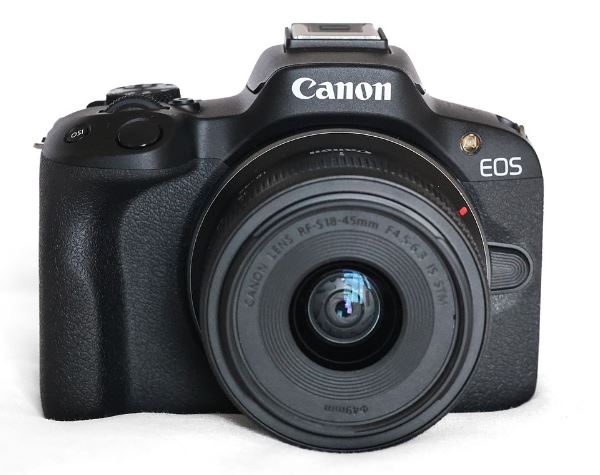
Published by the website Photons to Photo, has posted the measurement data of the dynamic range and high sensitivity performance of Canon’s new entry model “EOS R50”. We all know that Canon R10 and Canon R50 uses the same sensor, that’s why the result of both looks very similar.
| Model name |
Maximum dynamic range |
low light ISO |
Low light EV |
| EOS R50 |
10.57 |
1873 |
9.23 |
| EOS M50 |
9.84 |
1409 |
8.82 |
| EOS R10 |
10.54 |
1810 |
9.18 |
| Canon EOS R7 |
10.49 |
2213 |
9.47 |
| Z50 |
10.53 |
2406 |
9.59 |
| α6600 |
10.97 |
2929 |
9.87 |
| X-T30 |
10.47 |
3645 |
10.19 |
My Main concern is Canon’s lowlight performance, as you can the camera scores are lower than Nikon Z50 and A6600, we know that Nikon Z30 and Z50 share the same sensor, so we will have a better low-light performance from the Z50 or the Z30 compared to the R50 or the Canon R10.

As you can see from the difference in the low-light samples of the two, Nikon is able to preserve the color in the best way possible. Color box separation lines are clearly visible Nikon Z50 image sample compared to Canon R50.
Get LIVE RUMORS –> FACEBOOK | TWITTER | INSTAGRAM to get live news + Canon rumors 24X7
source photonstophotos
By admin, on March 7th, 2023
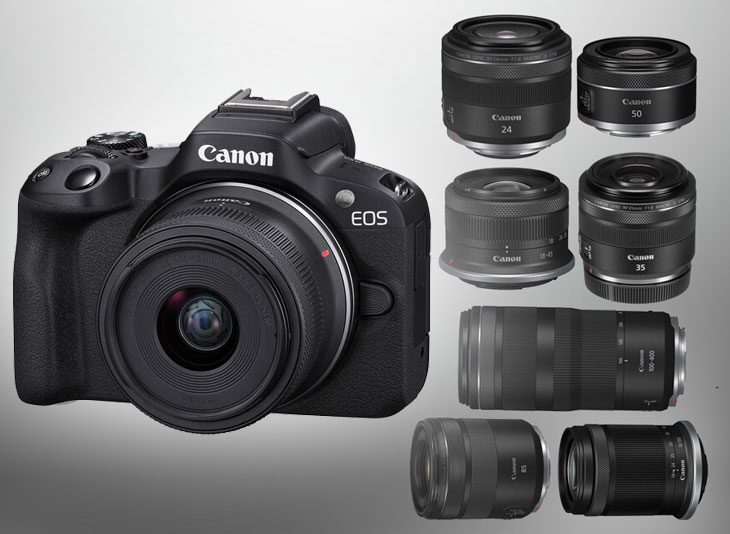
The best lenses for the Canon R50 Camera are here. The Canon R50 features excellent core specs and an advanced AF system similar to the Canon R10 camera. With the Canon R50 camera you can shoot oversampled 4k videos up to 30fps (10 BIT HDRPQ also available) and when shooting still images the Camera is able to capture a full-time burst speed of 15FPS with full-time AF/AF support. A total number of 4,503 manually selectable AF points are also available for precise autofocusing. One of the best entry-level Mirrorless cameras ever made by Canon with excellent internal still and video core specs.
In this post, we have selected some of the best lenses available for the Canon R50 camera. These lenses are best for Canon R50, as well as u can use these lenses for Canon R10 also. We have selected the native RF and RF-S Lenses for the Canon R10 camera. And at the end of the article, we have also added third-party lenses for the Canon R10 camera.
We have also made some comparison which includes Canon R10 vs Nikon Z50 and Canon R10 vs Sony A6400.
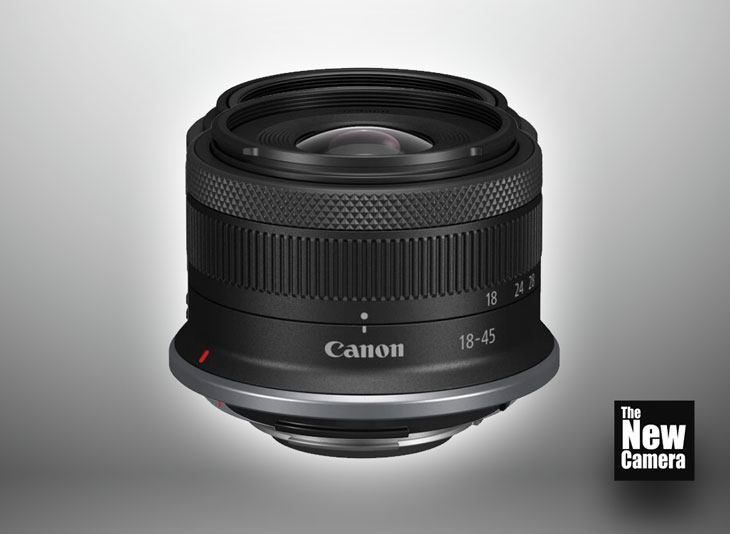
1. The most affordable zoom lens 18-45mm IS STM
The body of the Canon R10 cost $799 with the 18-45mm kit lens and without the lens, the cost of the camera body is $679. The actual cost of the lens is $269 when purchased separately from B&H. You are only paying $120 extra compared to $269 when u purchase it separately.
I know generally the kit lens quality is bad, but the 18-45mm IS STM Lens from Canon is really versatile. The focal length you are getting is perfect for landscape, nature, and family-friends photography.
The biggest advantage of the kit lens is the price factor and compactness. And at this price ur also get Image stabilization (OIS) and STM motors which is useful for both photography and videography. You can also click some decent portraits at 50mm.
Image stabilization in the 18-45mm Lens works very effectively. As we know the Canon R50 camera doesn’t have a built-in sensor-shift image stabilization system, so this lens will help you with its Optical Image stabilization feature. up to 4 stops of shake correction or up to 6 stops of Coordinated IS with a compatible camera body
The RF-S18-45mm f/4.5-6.3 IS STM has a Center Focus Macro function that captures close-up images with up to 0.26x magnification at 45mm (MF) Achieve up to 0.16x magnification at 45mm focal length with autofocus. When you are using the lens at Manual Focus mode At 35mm focal length it gives a maximum magnification of 0.59x.
.The Lens also features Canon STM Motor, which is extremely helpful while shooting videos, the STM motors generate minimal noise.
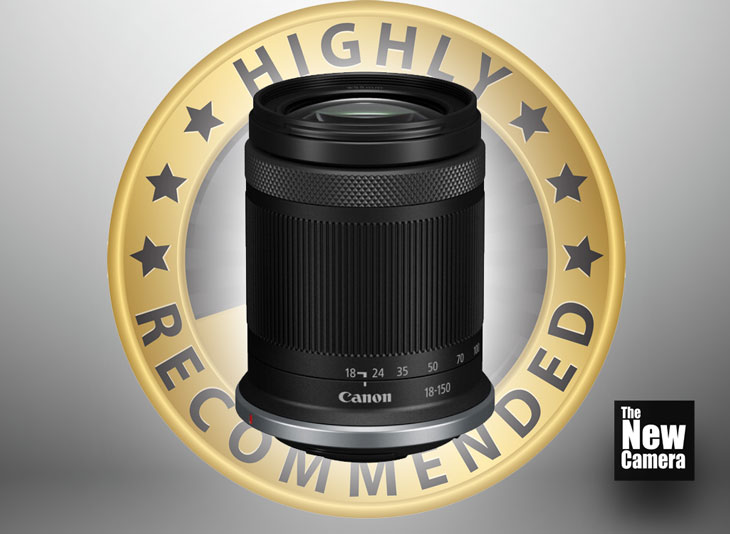
2. Canon RF 18-150mm Lens
The Canon’s 8.3x APS-C zoom Lens for Canon R10 packs in a useful 29-240mm (35mm equiv.) focal length range. When you feel your kit lens has limited zoom and you need a more versatile lens, the 18-150mm lens is made for you.
This lens is an all-in-one lens for the Canon R10 camera. Perfect those who don’t want to change the lens every time need an all-in-one solution. The Lens also acts as a coverage lens when you are into wedding photography and helps you a lot when u are in travel, covers a wide range of 18mm to tele-end 150mm.
The lens features an STM motor, and steeping drive motors are fast as well as silent Autofocusing work. Perfect for recording videos and shooting still images too. The OIS in this lens is highly effective and works up to 4.5 Stops, or up to 6.5 stops with Coordinated IS when paired with a compatible camera. Making it a perfect choice for shooting sharp images in low light.
The price of this lens is $499 (B&H Store and Amazon.com) You can use this lens as a default lens for your Canon R10 camera.
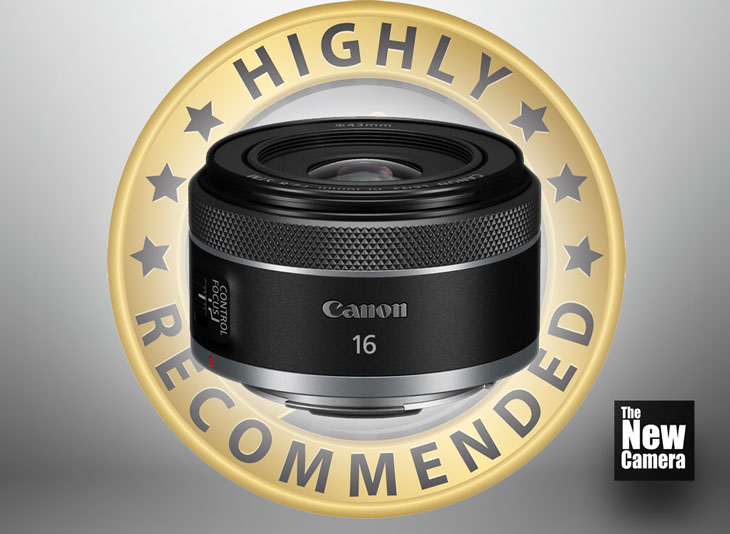
3. Canon RF 16mm F2.8 STM Lens
The Lens is a 16mm F2.8 Prime Lens (25mm equivalent), The 16mm Lens is the most affordable canon wide-angle prime lens for the Canon R50 camera with a bright F2.8 aperture and STM motor. The Lens is very compact as well as fast, a perfect lens for everyday use.
Perfect Lens for Handheld Vlogging: If you want to create handheld content, self-vlogging with a Canon R50 camera. The RF 16mm F2.8 STM is highly recommended. The Auto Focus of the lens and very smooth and fast, at the same time the F2.8 aperture helps you to create subject separation while filming and it also helps to capture perfect vlogs even in uncontrolled light conditions. Overall, the RF 16mm F2.8 STM is highly recommended for content creators.
If you want to extract, maximum sharpness you have to stop down to f/5.6, which will give you sharpness in the extreme edges and corners of the image frame. Highly essential while shooting Landscapes, architecture, or interiors with the Canon RF 16mm Prime Lens. The chromatic aberration is also very well controlled, even with automatic in-camera correction switched off. Vignetting is quite noticeable at f/2.8 but in-camera correction is also available for this, once active the in-camera correction then the RF16mm F2.8 Lens becomes a perfect lens without any issues.
The lens is priced at $279 (B&H Store and Amazon.com), the most affordable wide-angle prime lens in Canon RF-Mount, and must have lens for hand-held content creators.
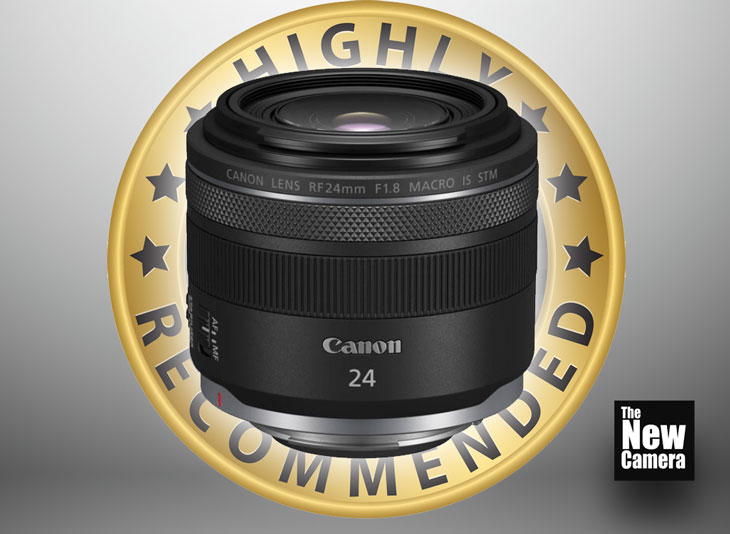
4. Canon RF 24mm F1.8 Macro IS STM Lens
If you own a Canon R50 camera, then for sure the most usable prime lens for you is the 24mm F1.8 Macro STM lens, the RF 24mm F1.8 Macro IS STM Lens equivalent focal length of this lens is 38mm which is near the standard focal length of 35mm. A perfect focal length for shooting landscape and street photography. This 24mm lens can be used for shooting family and friends’ portraits in a home in a low-light environment. Also perfect for capturing macro images due to its 1:2 magnification ratio and close-up shooting distance of 5.5 inches.
Perfect lens for YouTubers: The 24mm lens is a perfect tool for creating office and room vlogs, and also perfect for food photography and close-ups of your fav dish. You have to just maintain a 3 to 5 feet distance from your camera/rest your camera on a tripod, and start making your online content with excellent sharpness and creamy bokeh in the background.
The 24mm Lens is loaded with optical image stabilization, for the first time I have seen Canon giving us OIS features in Prime lenses like 24mm. The OIS is effective up to 5 stops, or 6.5 stops with coordinated IS, to better enable working handheld in low-light conditions and with slower shutter speeds. Whether you are creating videos with the lens or shooting still images the OIS helps all the time. We also have a full-time manual control option with the Configurable Control Ring of the lens, which can be used to adjust a variety of exposure settings, including aperture, ISO, and exposure compensation.
The lens is available at $499 (B&H Store and Amazon.com) You will feel the price is high. But also think twice that it’s a fullframe lens and will remain compatible with your camera even if you upgrade your camera to full frame. And despite being a 24mm Prime lens, the lens also features OIS and macro Capability, none of such features are available even in competitors’ prime lenses.
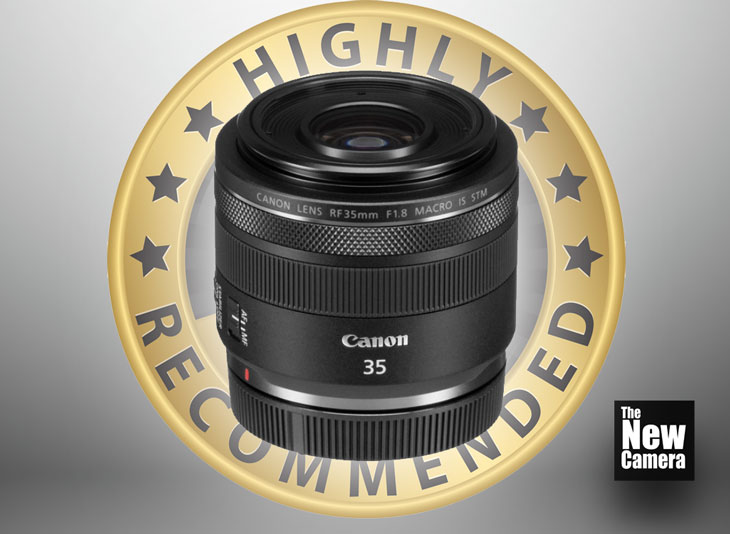
5. Canon RF 35mm F1.8 Macro IS STM
Perfect for professional-quality portraits with a Canon R50 camera. The Canon RF 35mm F1.8 when paired with Canon R50 gives you an equivalent focal length of 50mm Lens in full-frame format (due to Canon APS-C 1.6x crop factor) So it actually will act as a 50mm F1.8 with optical image stabilization and macro capability. A perfect lens for wedding pros, models & fashion photographers.
The size of this lens is slightly larger than the 24mm F1.8, It measures 74.4 x 62.8 mm and weighs 305g. However, this is still relatively light and compact and very easy to carry for the shoot. The lens pairs very comfortably with the canon R50 camera and has a sleek look and feel. There is a focus switch on the side of the lens, the lens does support full-time manual focus. That is, you can manually focus the lens by adjusting the focus ring even when the camera is set to autofocus.
With the Canon RF35mm F1.8 lens, you get an aperture range of f/1.8 – f/22, when the Max aperture when used helps to isolate the image from the environment with creamy background blur, it all helps you to generate a perfect cinematic output, with the additional Macro capability of the lens you get tack sharp images. The lens features Super Spectra coating that has been applied to individual elements to reduce the ghosting and flare for greater contrast and color neutrality when working in strong lighting conditions.
$499 (Amazon.com | B&H Store) is the price of a 35mm F1.8 IS STM Macro lens, this is a very reasonable price lens if you look at its features. The lens is a Fullframe lens and features Macro capability as well as optical image stabilization. We highly recommend this lens for the Canon R50 camera.

6. Canon RF 50mm F1.8 STM Lens
Best budget lens for photographers, if you want to shoot portraits with your camera a want a budget prime lens then the nifty-fifty Canon RF50mm F1.8 Lens is best for you. The RF 50mm lens is equivalent to 85mm when paired with a Crop sensor camera like Canon R50.
The telephoto prime lens measures 69 x 40 mm and weighs 160 g. This makes it the lightest lens on our list of prime lenses, balancing well with the weight of the camera. To suppress spherical aberrations Canon has introduced One precision-molded (PMo) aspherical element inside this lens, it also upscaled the sharpness and accurate subject rendering. Very light to carry around and excellent for beginners great view and clear pictures!
The overall image quality is fantastic. You’ll love how easy it is to snap incredibly sharp, beautiful photos using this lens, and your subjects will love it even more. Although the lens has a limited Macro capability of 50cm, so if you want a better macro-performing lens you have to buy the other two primes (24mm and 35mm) mentioned above in the list.
With a price tag of $199 (B&H Store | amazon.com) Canon RF 50mm, F1.8 STM Lens is the most affordable prime lens in RF lineup. The reason behind that is the lens doesn’t have the OIS like the other prime lenses as well as macro capability.
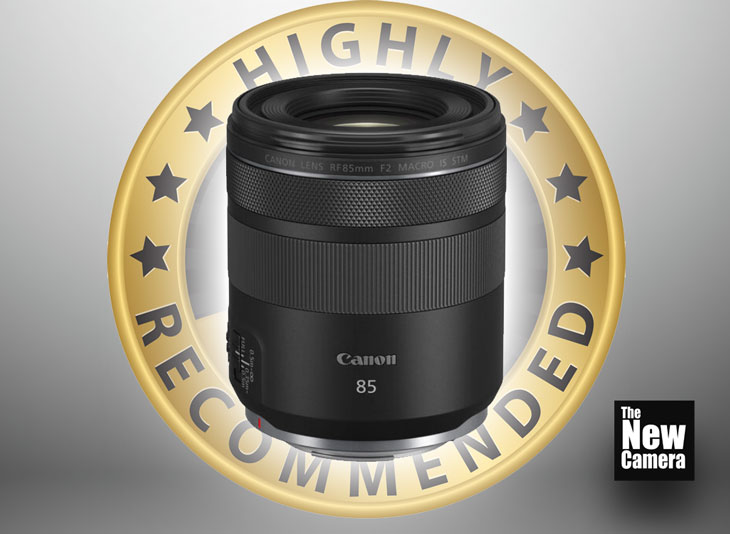
7. Canon 85mm F2 IS STM Macro
The ultimate portrait lens for professionals, Canon 85mm F2 Macro Lens features optical image stabilization, Macro capability as well as a stepping drive motor for smooth yet fast focusing transitions. The equivalent focal length of an 85mm lens on the Canon R50 body will be 136mm. It reminds me of Canon’s popular 100mm F2.8 Macro Lens. The lens can be used effectively when you want to capture wildlife’s beauty without disturbing them. 85mm (136mm on R50) will allow you to work from a distance and also 5 stops of Optical Image stabilization within. So, you can also take some amazing macro shots or portraits of models handheld.
The tele – prime lens measures 78 x 90.5 mm and weighs 500 g. This makes it the largest and the heaviest lens on our list, Configurable Control Ring can be used to adjust a variety of exposure settings, including aperture, ISO, and exposure compensation. The rounded nine-blade diaphragm contributes to a pleasing bokeh quality.
The lens creates creamy bokeh at F2 and is perfect for portraits, I have used this lens with a Canon R5 camera and at F3.5 to 5.6 the lens produces razor-sharp images with an exceptional amount of details resolved through the sensor. With its macro capability, the lens is able to do 1:2 maximum magnification along with a minimum focusing distance of 1.15. And the Configurable Control Ring on this lens can be used to adjust a variety of exposure settings, including aperture, ISO, and exposure compensation.
The price tag $549 (B&H Store | amazon.com) price makes this lens one of the most costly prime lenses on our list. although with Optical image stabilization, Macro capability, a Steeping drive motor, and a rounded nine-blade diaphragm make this lens the perfect choice for professional photographers.

8. Canon RF 100-400mm f/5.6-8 USM
Prime lenses do give the best quality possible since they have minimal moving lens elements inside them optimized for the best performance. However, zoom lenses like the 100-400 are also a worthwhile investment.
With prime lenses, if you want to have an optical crop you have to physically move toward your subject. This isn’t always possible depending on what or where you’re shooting. So, we have lenses like the 100-400mm (equivalent focal length 160mm – 640mm).
The resolving power of this lens is just amazing even when paired with the Canon R5 camera, lens features Max magnification up to .41X @ 400mm. So, it’s worthwhile to say the lens also has macro capability. To reduce the chromatic aberrations and color fringing throughout the zoom range the lens has One Ultra-Low Dispersion element. The lens features a built-in optical image stabilization system effective up to 4 stops when used with R10, and up to 6 stops of camera shake and Nano USM AF to promote faster focusing performance.
You have to pay $599 (B&H Store | Amazon.com) to get this lens, It may look pricy to you. But the sharpness, OIS, Bokeh, and AF performance are highly impressive. Equivalent to equivalent focal length 160mm – 640mm when used with APS-C body and 100-400 when used with Full frame.
By admin, on February 11th, 2023

Yes, the Canon R50 camera doesn’t have a fully mechanical shutter inside the camera, instead of that we have HYBRID and ELECTRONIC. Shutter
Just after the announcement of the Canon R50 camera, I am getting lots of msgs from my users about why we have only two options on the shutter menu of the camera that say
- Elec. first curtain shutter
- Electronic only
But, when you go the burst mode, you have two options: the first is a 12FPS mechanical, and the second is a 15fps electrical shutter.
Ideal Condition to remove Mechanical shutter from your camera
- Condition 1: If the camera sensor has a GLOBAL SHUTTER without any lag, yes the camera doesn’t need any mechanical shutter.
- Condition 2: When a Camera Maker is using a STACKED CMOS Sensor inside the camera as we have in Nikon Z9, Sony ALPHA A1, or Canon R3, OR EVEN a re-worked FSI (Front Side illuminated Sensor) like we have in Canon R6 Mark II and Canon R8.
Now, these are the ideal condition to remove MECHANICAL SHUTTER completely from your camera.
THE BIG BUT
If your camera uses a slow traditional FSI (Front Side illuminated Sensor) and even knowing those stuff you completely attempt to remove the Fully Mechanical Shutter system from your camera it’s not recommended.
Since Both the EFCS Shutter and the Fully Electronic Shutter have some limitations. Specifically when paired with slow-readout-based sensors.
BASIC RULES TO FOLLOW as a PHOTOGRAPHER
1. If the shutter speed drops below 1/100 turn EFCS ON to prevent the front mechanical curtain from affecting your sharpness.
2. If the shutter speed goes above 1/1000 and you shoot a shallow depth of field turn EFCS OFF. The reason is that EFCS affects badly defocus characteristics of lenses when going above 1/1000
If your shutter speed is in between 1/100 and 1/1000 it is your call what to use. In general, when you do not shoot shallow depth-of-field portraits EFCs turned on is a good thing. When you put on the 135/1.8 or the Batis lens or even the 55/1.8 EFCS MUST go if you want nice bokeh
SHARE YOUR THOUGHTS WITH US
If the decision to remove the mechanical shutter from Canon R50 is correct?
Get LIVE RUMORS –> FACEBOOK | TWITTER | INSTAGRAM to get live news + Canon rumors 24X7
By admin, on February 9th, 2023
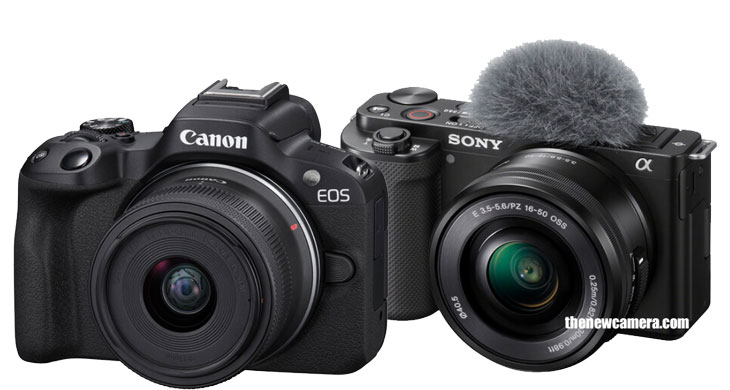
Let’s talk about the body design of both the camera the Canon R50 camera is more photographer friendly with the EVF and the deep hand grip that is missing in the Sony ZV-E10 camera
As you can clearly see Canon R50 and Sony ZV-E10 have different design approaches, Canon R50 has a more traditional, like a DSLR camera with a deep handgrip and also EVF for daylight shooting, while the Sony ZV-E10 may have a more modern, bit more compactish design that looks more vlogger friendly. Ultimately, the best camera for you will depend on your specific needs, shooting style, and set of available lenses (Open lens mount or close etc )
If you are a photographer and looking for a camera that has a more photographer-friendly design, it’s better to look up the Nikon z50 or maybe the Sony A6400.
But we have to also remember that the Canon RF mount supports a limited amount of lenses since it’s a closed mount and in Sony, we have an amazing range of lenses starting from the affordable to the g master series and the Sony lens amount of Sony is open from 2011. so literally, you have to be very conscious before making your decision
Get Canon R50 From Amazon.com | B&H Store
Get Sony ZV-E10 Camera from Amazon.com | B&H Store
| Lens Mount |
Canon RF |
Sony E |
| Sensor Resolution |
Effective: 24.2 Megapixel |
Actual: 25 Megapixel
Effective: 24.2 Megapixel (6000 x 4000) |
| Sensor Type |
22.3 x 14.9 mm (APS-C) CMOS |
23.5 x 15.6 mm (APS-C) CMOS |
| Crop Factor |
1.6x |
1.5x |
| Image Stabilization |
None (Video)
|
Digital (Gyro Based) |
| Built-In ND Filter |
None |
None |
| Capture Type |
Stills & Video |
Stills & Video |
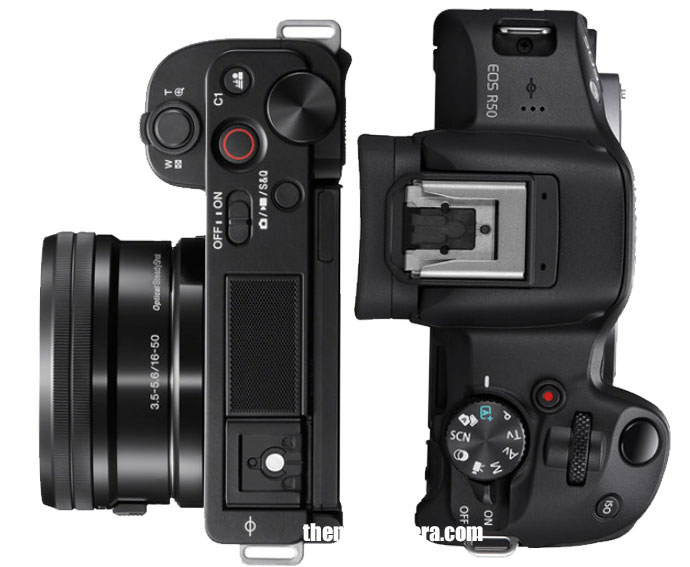
After the body design let’s compare the internal core specification of both cameras.
The Canon R50 camera features the same 24-megapixel sensor that we have seen in the Canon R10 camera, and also here the Sony ZV-E10 camera uses 24MP sensor, which we have seen in the Sony 6400 camera or A6600 camera.
| Shutter Type |
Electronic Shutter |
Electronic Shutter, Mechanical Focal Plane Shutter |
| Shutter Speed |
Electronic Shutter
1/8000 Up to 30 Seconds
Electronic Front Curtain Shutter
1/4000 Up to 30 Seconds |
Mechanical Shutter
1/4000 to 30 Seconds
1/4000 to 1/4 Second in Movie Mode |
| Bulb/Time Mode |
Bulb Mode, Time Mode |
Bulb Mode |
| ISO Sensitivity |
Photo/Video
100 to 32,000 (Extended: 51,200) |
Photo
100 to 32,000 in Auto Mode (Extended: 50 to 51,200)
Video
100 to 3200 |
| Metering Method |
Center-Weighted Average, Evaluative, Partial, Spot |
Center-Weighted Average, Multi-Zone, Spot |
| Exposure Modes |
Aperture Priority, Manual, Program, Shutter Priority |
Aperture Priority, Auto, Manual, Program, Shutter Priority |
| Exposure Compensation |
-3 to +3 EV (1/3 EV Steps) |
-5 to +5 EV (1/3, 1/2 EV Steps) |
| Metering Range |
-2 to 20 EV |
-2 to 20 EV |
| White Balance |
Presets: Auto, Cloudy, Color Temperature, Custom, Daylight, Flash, Fluorescent (White), Shade, Tungsten |
Presets: Auto, Cloudy, Color Temperature Filter, Custom, Daylight, Flash, Fluorescent (Cool White), Fluorescent (Day White), Fluorescent (Daylight), Fluorescent (Warm White), Incandescent, Shade, Underwater |
| Continuous Shooting |
Electronic Shutter
Up to 15 fps for up to 28 Frames (JPEG) / 7 Frames (Raw)
Electronic Shutter
Up to 12 fps for up to 42 Frames (JPEG) / 7 Frames (Raw) |
Up to 11 fps at 24.2 MP for up to 116 Frames (JPEG) / 46 Frames (Raw) |
| Interval Recording |
Yes |
Yes |
| Self-Timer |
2/10-Second Delay |
2/5/10-Second Delay |
AutoFocus Performancee
As you can see the number of AF points in Canon R50 is 4503 DPAF points for stills and 3713 DPAF points for Video. And when we compare it with the Sony’s ZV-E10 425 Hybrid AF points the comparison look meaningful less for a moment, but its not about how many numbers of AF points a camera has or fabricated inside it, the key factor of todays Mirrorless AF system in the Artificial Intelligent Algorithms inside the camera, and that’s the biggest reason why despite of having less number of AF points the AF performance of The Sony ZV-E10 is flawless.
| Focus Type |
Auto and Manual Focus |
Auto and Manual Focus |
| Focus Mode |
Continuous-Servo AF, Manual Focus, Single-Servo AF |
Automatic, Continuous-Servo AF, Direct Manual Focus, Manual Focus, Single-Servo AF |
| Autofocus Points |
Photo
Phase Detection: 4503
Video
Phase Detection: 3713 |
Phase Detection: 425
Contrast Detection: 425 |
|
|
-3 to +20 EV |
Canon R10 – Fastest Shooting Entry-level camera
For the first time Canon has introduced an electronic shutter inside an Entry level body, now with the help of an electronic setter we are able Burst upto 15FPSbut, but sadly the buffer is limited to 30 Frames of JPEG, so you can hardly have two second buffer slot with the Canon R50 Camera.
Sony ZV-E10 camera has a limited Brust speed of 11 frames per second, but at the same time the buffer memory of Sony’s ZV-E10 camera is much more than that of the Canon R50, with the ZV-E10 camera you are able to record 116 frames of JPEG in a single Brust and 46 frames of RAW0
Since Canon R50 camera uses a Canon R10 camera sensor and the samples of Canon R5 isn’t available right now, that’s why we are keeping the R10 image samples in our comparison list, so you can have an idea how will R50 will perform against the Sony ZV-E10
BASE ISO TEST

In the base are you so test you can clearly see both cameras are performing equally well, the detail capturing ability of both the camera is good at the base ISO range.
HIGH ISO TEST

Now let’s talk about the HIGH ISO TEST of both the camera, As now you can see the Sony ZV-E10 camera is able to preserve slightly more details in some specific situations compared to the Canon R50 Mirrorless camera, so for low light purposes of course Nikon ZV-E10 is bit more helpful.
Video Specs
| Internal Recording Modes |
H.264/H.265/MPEG-4
UHD 4K (3840 x 2160) at 23.98/25/29.97 fps
1920 x 1080 at 23.98/25/29.97/50/59.94/100/120 fps |
H.264/H.265/MPEG-4
UHD 4K (3840 x 2160) at 23.98/25/29.97 fps
1920 x 1080 at 23.98/25/29.97/50/59.94/100/120 fps |
| Broadcast Output |
NTSC/PAL |
NTSC/PAL |
| Built-In Microphone Type |
Stereo |
Stereo |

Best Entry-Level Camera to Record Videos?
Both cameras share exactly the same video Resolution and frame rates, Canon R50 camera as well as the Sony’s ZV-E10 camera records 4K videos up to 30 FPS and full HD videos up to 120 per second. So, for the first time, we have a Canon entry-level model that doesn’t crop in 4K. Undoubtedly it will bring smiles in face of Canon users, those who are waiting to upgrade their cameras from Canon M50 Mark ii or Canon 200D Mark II / SL3 . But, at the same time in 3rd generation of making APS-C Mirrorless cameras, the ZV-E10 is more video oriented and focuses on content creator requirements.
None of the cameras have any time recording limit in 4K 24 and 30 FPS recording video, but yes you have to carry extra battery packs says the batteries dry out quickly with these entry-level cameras when you are recording 4K.
Canon features DIGITAL Image stabilization mode in VIDEO, which we see generally in entry-level cameras, the mode works but with a cost of crop and it becomes unbearable and painful to your hands when you try to vlog with the Canon 18-45 kit lens, the 18mm wide generates a 24mm equivalent focal length of a full-frame camera and after that, once you apply Digital IS Mode, you hardly adjust yourself in the frame. So, if you want to vlog with an R50 camera, better to buy the Canon’s 15-30mm Lens OR at least an RF 16mm F2.8 Lens. But, unfortunately, the RF 16mm lens doesn’t have OIS Support. To better get the 15-30mm lens for vlogging if possible. As you know, we don’t have many options with Canon since the lens mount is locked and we have to select from a limited range of lenses.
Best lenses for Sony ZV-E10
But, the biggest surprise is we have a gyro image stabilization system inside the Sony ZV-E10 which works very effectively when you are shooting videos with the camera. Although using Gyro-based data is not that easy, either you have to use the catalyst browse software to stabilize your footage prior to editing, or Sony now also offers Catalyst plugin for premier pro software.
The range of available lenses is much more than you would expect, The Best Sony ZV-E10 Lens for Vlogging in 2023 is Sony 11mm F1.8 Lens, The lens captures a super wide 16mm full-frame equivalent look and a BRIGHT F1.8 aperture perfect for vlogging.
The Sony ZV-E10 also features a 3-capsule-based enhanced internal microphone design that captures audio much better than you would expect from a regular entry-level camera, as well as to monitor that audio you also get an extra 3.5mm headphone port. Which is not available with the Canon R50.
Of course, a Range of dedicated modes is also there which includes face exposure priority, product showcase, and skin softening mode for vloggers.
Interface
| Media/Memory Card Slot |
Single Slot: SD/SDHC/SDXC |
Single Slot: SD/SDHC/SDXC/Memory Stick Duo Hybrid (UHS-I) |
| Video I/O |
1 x Micro-HDMI Output |
1 x Micro-HDMI Output |
| Audio I/O |
1 x 1/8″ / 3.5 mm TRS Stereo Microphone Input on Camera Body |
1 x 1/8″ / 3.5 mm TRS Stereo Headphone Output
1 x 1/8″ / 3.5 mm TRS Stereo Microphone Input |
| Other I/O |
1 x USB-C Input/Output |
1 x USB-C Input/Output |
| Wireless |
2.4 / 5 GHz Bluetooth 4.2 Control |
1 x USB-C (USB 3.2 / 3.1 Gen 1) Input/Output (Shared with Power Input) |
| Mobile App Compatible |
Yes
*As of February, 2023: Check with manufacturer for the most up-to-date compatibility |
Wi-Fi, Bluetooth |
| Global Positioning (GPS, GLONASS, etc.) |
None |
None |
Best Camera for shooting Still Images and video?
Canon R50 overall design is more appealing to photographers since the camera also features EVF and a better handgrip, we also have an advanced AF system with AI AF object tracking mode and faster burst speed it looks ver impressive. But, at the same time you can see from the results of the High ISO Test, the Sony ZV-E10 sensor is preserving more details, if u want a more video-oriented camera with features like an advance microphone, dual 3.5mm jack, gyro-based IS, and product showcase mode, ZV-E10 best for you.
The Next BIG thing is Canon’s Locked lens mount. So, the range of lenses for an entry-level shooter is less (if you have a limited-budget lens ).
So, overall it depends upon who is buying the camera if he/she is a casual shooter. Not interested in having extra lenses and love the R50 design, then yes for you guys the R50 is best. But for those who are more serious with photography or video at the same time they have a limited budget, better to buy a Sony ZV-E10 camera (or A6400 is you are a photographer).
Get Canon R50 From Amazon.com | B&H Store
Get Sony ZV-E10 Camera from Amazon.com | B&H Store
|
KEEP THIS BLOG ALIVE - Support New Camera Buy Canon Lenses, Buy Music CD or Digital Camera at amazon it helps this site, and you do not pay anything extra, it is just a way to help support this site.

|






























